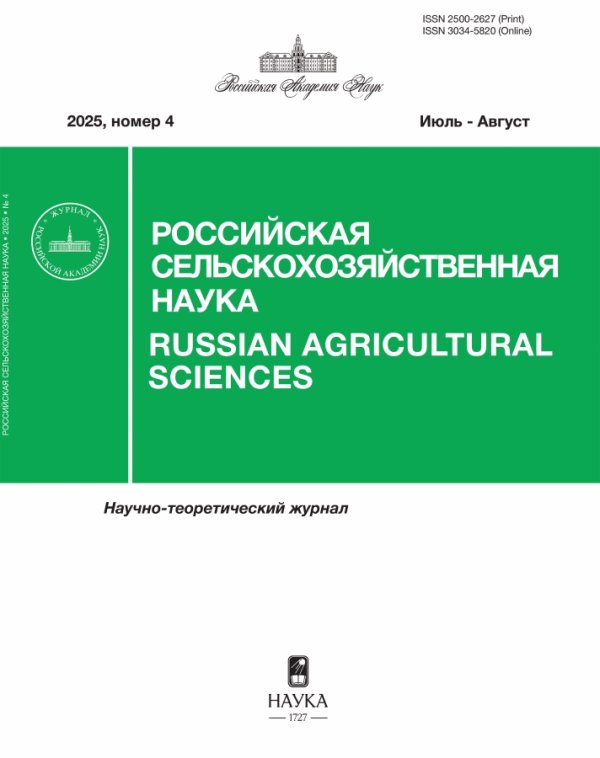Russian Agricultural Sciences
Russian Agricultural Sciences is an international peer-reviewed journal that publishes reviews and original contributions in all areas of agriculture, biological sciences, biotechnology and ecology. Subject headings are as follows: crop cultivation, genetics, selection, plant growing, and horticulture; plant physiology and biochemistry; plant protection; agrochemistry, soil science; processing and storage of farm products; ecology animal husbandry, genetics, and selection; animal physiology and biochemistry; breeding; veterinary science; animal feel and mechanization. The journal welcomes manuscripts from all countries.
Media registration certificate: ПИ № ФС 77 – 63275 от 06.10.2015
Current Issue
No 4 (2025)
Crop production, plant protection and biotechnology
Characteristics of promising accessions of spring durum wheat breeding by the Federal Center of Agriculture Research of the South-East region for the leaf diseases resistance
Abstract
 3-8
3-8


Factor Analysis of Oats Productivity Elements
Abstract
 9-13
9-13


Productivity and grain quality of oat varieties in the Volga region
Abstract
 14-18
14-18


Allelic diversity of the FaOMT gene of the strawberry fruit aromatic complex
Abstract
 19-22
19-22


Evaluation of the adaptive potential of Chelyabinsk honeysuckle varieties in the conditions of the Southern Urals and Krasnoyarsk Territory
Abstract
 23-28
23-28


Current aspects of the production of planting grapes of the highest quality categories
Abstract
The research was carried out in order to develop an algorithm for the production of planting material for grapes of the highest quality categories using modern bio- and digital technologies based on the identification of the influence of agrometeorological (weather) and chemical and man-made factors on the yield of seedlings. The work used materials from nursery breeding organizations of the Krasnodar Territory for 2000–2024, databases of agro-climatic indicators of the grape growing region. The key problems requiring the adjustment of the methodological foundations of the production of planting grapes of the highest quality categories have been identified. Based on the correlation analysis, a relationship was established between the influence of agrometeorological (weather) conditions on the yield of planting material (the relationship is statically significant, as evidenced by various statistical me trics: the coefficient of determination is 0.915, the standard error of the model is 0.32, the P-value (F) is 64.5, the Akaike criterion is 1.35). The calculated decapling effect (integral score 0.32) allows us to conclude that there is an increase in pesticide pressure and pathogenic effects on the elements of the grape nursery system, which reduces the yield of planting material of the highest quality categories. It has been established that the cultivation of seedlings of the highest quality categories should be carried out taking into account the revealed direct relationship between their production and chemical and man-made impacts, applied agrobiotechnologies in accordance with the current regulatory framework and the developed algorithm. The features of the proposed algorithm are: the introduction of the «candidate for source plants» category, the inclusion of additional testing for viruses, bacteria, phytoplasmas and other harmful organisms, the maintenance of source plants in protected soil conditions, the inclusion of varietal and phytosanitary testing of the «source» grape queen no earlier than the second year of vegetation. Taking into account the predicted technological shifts and the peculiarities of the production of grape seed as a perennial crop, it was determined that the most promising ways of growing it will be biotechnologies based on molecular biology, biochemistry and genetic engineering; bioinformatics; nano- and cellular technologies; artificial intelligence systems.
 29-36
29-36


Efficiency of herbicide treatment of spring barley crops under conditions of moisture deficiency in the North-West of Russia
Abstract
 37-40
37-40


Influence of nutrient medium and air temperature on development of sclerotia of Sclerotinia sclerotiorum (Lib.) de Bary in laboratory
Abstract
 41-45
41-45


Agro-soil science and agroecology
Assessment of carbon reserves in grey forest soils under different types of land use
Abstract
 46-53
46-53


Assessment of gaseous ammonia losses when using urea and urea-formaldehyde fertilizers
Abstract
 54-58
54-58


Mechanization, electrification, automation and digitalization
Methodological Foundations for the Integration of Unmanned Aerial Vehicles into Agricultural Machinery Systems
Abstract
 59-67
59-67


Determination of the Rational Value of the Intercondition of the Working Bodies of a Transformable Discator
Abstract
 68-72
68-72












